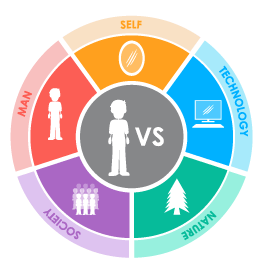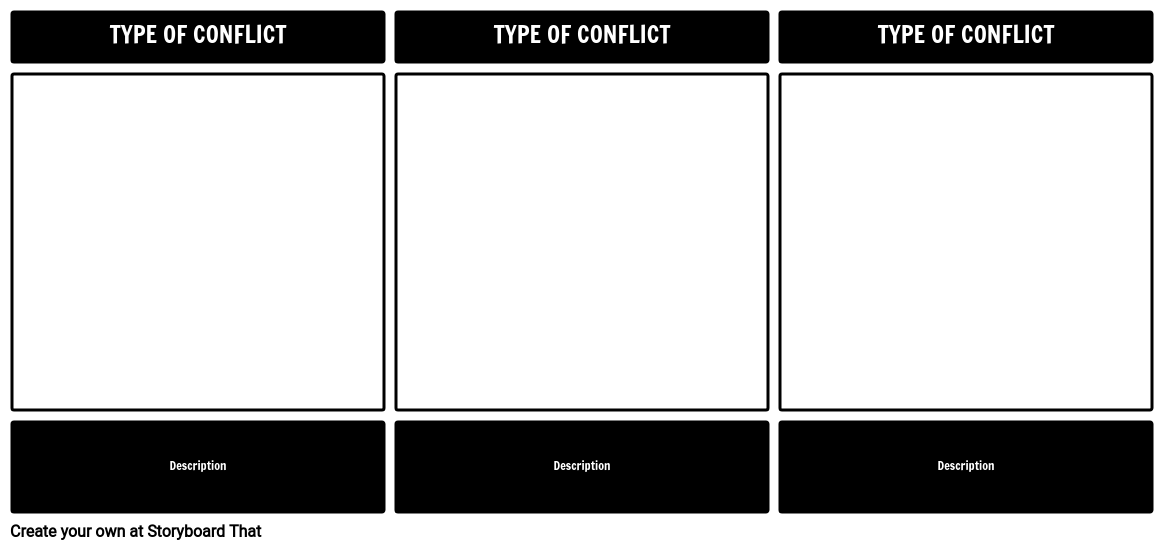Activity Overview
Literary conflicts are often taught during ELA units. Building on prior knowledge to achieve mastery level with our students is important. An excellent way to focus on the various types of literary conflict is through storyboarding. Having students choose an example of each literary conflict and depict it using the storyboard creator is a great way to reinforce your lesson!
In Othello, conflict is ever present. Much of it arises from the machinations of Iago, which ultimately cause Othello's downfall. In each act, Iago's need for revenge causes the other characters misfortune and death.
Examples of Literary Conflict from Othello
MAN vs. MAN
Iago tries to kill Cassio, motivated by anger over a promotion which Cassio received instead of Iago.
MAN vs. SELF
Othello questions Desdemona's devotion, and eventually loses his battle to keep this jealousy in check.
MAN vs. SOCIETY
Othello is a Moor. The prejudice and racism of his society makes others suspicious of him. They do not understand how he is a general, and how he won the love of Desdemona.
Template and Class Instructions
(These instructions are completely customizable. After clicking "Copy Activity", update the instructions on the Edit Tab of the assignment.)
Student Instructions
Create a storyboard that shows at least three forms of literary conflict in Othello.
- Identify conflicts in Othello.
- Categorize each conflict as Character vs. Character, Character vs. Self, Character vs. Society, Character vs. Nature, or Character vs. Technology.
- Illustrate conflicts in the cells, using characters from the story.
- Write a short description of the conflict below the cell.
Lesson Plan Reference
Rubric
(You can also create your own on Quick Rubric.)
| Proficient | Emerging | Beginning | Try Again | |
|---|---|---|---|---|
| Conflict Identification | Student identifies correct major conflicts and uses strong, clear textual evidence to support choice. | Student identifies correct major conflict and uses few or unclear details to support their choice. | Student identifies incorrect major conflict, and uses some details from the text to support their choice. | Student does not attempt to identify major conflict or identifies incorrect major conflict with no explanation. |
| Understanding Outcome | Student clearly shows the outcome of the conflict and its effects on the protagonist with evidence from the text. | Student shows the outcome of the conflict and its effect on the protagonist, but some evidence is unclear. | Student shows the outcome of the conflict, but does not examine its effect on the protagonist and uses some vague textual evidence. | Student does not clearly show the outcome of the conflict or use textual evidence. |
| Character | Storyboard includes all required characters and clearly names them. Goes above and beyond by adding additional details. | Storyboard includes all required characters and clearly names them. | Storyboard includes protagonist and antagonist but leaves out other required characters. | Storyboard does not include the names of required characters. |
| Storyboard | Student clearly shows effort to convey the setting the scene of the book | Student attempts to convey setting and scene of the book, but lacks some clarity. | Student does not clearly convey the setting and scene. | Student makes little or no attempt to convey the setting or scene. |
| Spelling and Grammar | Student uses exemplary spelling and grammar. There are no errors. | Student makes a minor error in spelling and grammar. | Student makes several minor errors in spelling and grammar. | Student makes many errors in spelling and grammar; little attempt at spellchecking. |
How To Identify Different Conflicts in Othello
Introduce the Play and Themes
Introduce "Othello" to your students to get things started. Discuss the main themes of love, manipulation, racism, and jealousy in brief, as well as the environment and characters. Engage students in interesting activities while reading and understanding the play.
Explain Conflict
Explain to students the definition and different types of conflicts that are present in the play. Describe how conflict influences the development of the story and characters in literature. Ask the students to describe any type of conflict they observed while reading the play.
Talk in Depth About the Types of Conflicts
Start by giving some more details about the types of conflicts. Begin with the most basic types such as character vs character, character vs society, and character vs self. After students are able to comprehend the basic types, move on to the more complex types.
Use Open Ended Questions
Guide the discussion on the conflicts using open ended questions. These questions can provide some new insights to students and help them concentrate on the center of the discussion.
Give Examples
Teachers can help students in the identification of conflicts in Othello by providing examples of conflicts from other similar plays or writings. Students can compare these examples and make some analysis of their own.
Frequently Asked Questions About Literary Conflicts in Othello
What are the key conflicts in “Othello”?
The central disputes in "Othello" encompass both internal and foreign disputes. Characters engaged in internal conflicts while those engaged in external conflicts battle it out with one another.
What is the source of Othello's internal conflict?
Othello's passion for Desdemona and his confidence in Iago cause him to struggle deeply inside. He struggles with resentment, insecurity, and his unwillingness to accept the idea that Desdemona could be unfaithful.
What part does race play as a point of contention in the play?
Othello feels insecure because of how different he is from other members of Venetian society because of his race. Additionally, it gives Iago a way to control him by inflaming Othello's jealousy and self-doubt through the use of racial stereotypes.
How do the character conflicts exemplify larger themes?
Larger themes like envy, manipulation, trust, and the catastrophic force of unrestrained emotions are reflected in the confrontations between characters. These disagreements serve as a reminder of how brittle interpersonal bonds are and how susceptible people are to outside forces.
More Storyboard That Activities
Tragedy of Othello, the Moor of Venice, The
© 2024 - Clever Prototypes, LLC - All rights reserved.
StoryboardThat is a trademark of Clever Prototypes, LLC, and Registered in U.S. Patent and Trademark Office











